Usefulness and Limitations of PFGE Diagnosis and Nucleotide Sequencing Method in the Analysis of Food Poisoning Pathogens Found in Cooking Employees
Abstract
1. Introduction
2. Results
2.1. PFGE Results of the Types of Bacteria Isolated in the Food Poisoning Outbreak
2.2. Nucleotide Sequencing Results of the Types of Norovirus Isolated in the Food Poisoning Outbreak
3. Discussion
4. Materials and Methods
4.1. Outbreak Characteristics (Subjects)
4.2. Sample Collection and Isolation of Pathogen
4.3. Genetic Fingerprint Analysis of Bacterial Testing in Food Poisoning
4.4. Genotype Analysis of Virus Testing in Food Poisoning
5. Conclusions
Author Contributions
Funding
Institutional Review Board Statement
Informed Consent Statement
Data Availability Statement
Conflicts of Interest
References
- Holland, D.; Thomson, L.; Mahmoudzadeh, N.; Khaled, A. Estimating deaths from foodborne disease in the UK for 11 key pathogens. BMJ Open Gastroenterol. 2020, 7, e000377. [Google Scholar] [CrossRef] [PubMed]
- Bintsis, T. Foodborne pathogens. AIMS Microbiol. 2017, 3, 529–563. [Google Scholar] [CrossRef] [PubMed]
- World Health Organization. Estimating the Burden of Foodborne Diseases. Available online: https://www.who.int/activities/estimating-the-burden-of-foodborne-diseases (accessed on 21 February 2024).
- Duret, S.; Pouillot, R.; Fanaselle, W.; Papafragkou, E.; Liggans, G.; Williams, L.; Van Doren, J.M. Quantitative Risk Assessment of Norovirus Transmission in Food Establishments: Evaluating the Impact of Intervention Strategies and Food Employee Behavior on the Risk Associated with Norovirus in Foods. Risk Anal. 2017, 37, 2080–2106. [Google Scholar] [CrossRef] [PubMed]
- Hall, A.J.; Vinjé, J.; Lopman, B.; Park, G.W.; Yen, C.; Gregoricus, N.; Parashar, U. Updated norovirus outbreak management and disease prevention guidelines. MMWR Recomm. Rep. 2011, 60, 1–18. [Google Scholar]
- Carpenter, L.R.; Green, A.L.; Norton, D.M.; Frick, R.; Tobin-D’Angelo, M.; Reimann, D.W.; Blade, H.; Nicholas, D.C.; Egan, J.S.; Everstine, K.; et al. Food worker experiences with and beliefs about working while ill. J. Food Prot. 2013, 76, 2146–2154. [Google Scholar] [CrossRef] [PubMed]
- Sumner, S.; Brown, L.G.; Frick, R.; Stone, C.; Carpenter, L.R.; Bushnell, L.; Nicholas, D.; Mack, J.; Blade, H.; Tobin-D’Angelo, M.; et al. Factors associated with food workers working while experiencing vomiting or diarrhea. J. Food Prot. 2011, 74, 215–220. [Google Scholar] [CrossRef] [PubMed]
- Norton, D.M.; Brown, L.G.; Frick, R.; Carpenter, L.R.; Green, A.L.; Tobin-D’Angelo, M.; Reimann, D.W.; Blade, H.; Nicholas, D.C.; Egan, J.S.; et al. Managerial practices regarding workers working while ill. J. Food Prot. 2015, 78, 187–195. [Google Scholar] [CrossRef] [PubMed]
- Marineli, F.; Tsoucalas, G.; Karamanou, M.; Androutsos, G. Mary Mallon (1869–1938) and the history of typhoid fever. Ann. Gastroenterol. 2013, 26, 132–134. [Google Scholar] [PubMed]
- Aladhadh, M. A Review of Modern Methods for the Detection of Foodborne Pathogens. Microorganisms 2023, 11, 1111. [Google Scholar] [CrossRef]
- Kabiraz, M.P.; Majumdar, P.R.; Mahmud, M.M.C.; Bhowmik, S.; Ali, A. Conventional and advanced detection techniques of foodborne pathogens: A comprehensive review. Heliyon 2023, 9, e15482. [Google Scholar] [CrossRef]
- Elbehiry, A.; Abalkhail, A.; Marzouk, E.; Elmanssury, A.E.; Almuzaini, A.M.; Alfheeaid, H.; Alshahrani, M.T.; Huraysh, N.; Ibrahem, M.; Alzaben, F.; et al. An Overview of the Public Health Challenges in Diagnosing and Controlling Human Foodborne Pathogens. Vaccines 2023, 11, 725. [Google Scholar] [CrossRef]
- Liao, F.; Gu, W.; Yang, Z.; Mo, Z.; Fan, L.; Guo, Y.; Fu, X.; Xu, W.; Li, C.; Dai, J. Molecular characteristics of Staphylococcus aureus isolates from food surveillance in southwest China. BMC Microbiol. 2018, 18, 91. [Google Scholar] [CrossRef] [PubMed]
- Yang, S.C.; Lin, C.H.; Aljuffali, I.A.; Fang, J.Y. Current pathogenic Escherichia coli foodborne outbreak cases and therapy development. Arch. Microbiol. 2017, 199, 811–825. [Google Scholar] [CrossRef]
- Park, J.H.; Oh, S.S.; Oh, K.H.; Shin, J.; Jang, E.J.; Jun, B.Y.; Youn, S.K.; Cho, S.H. Diarrheal outbreak caused by atypical enteropathogenic Escherichia coli O157:H45 in South Korea. Foodborne Pathog. Dis. 2014, 11, 775–781. [Google Scholar] [CrossRef] [PubMed]
- Qi, X.; Alifu, X.; Chen, J.; Luo, W.; Wang, J.; Yu, Y.; Zhang, R. Descriptive study of foodborne disease using disease monitoring data in Zhejiang Province, China, 2016–2020. BMC Public Health 2022, 22, 1831. [Google Scholar] [CrossRef] [PubMed]
- Watari, T.; Tachibana, T.; Okada, A.; Nishikawa, K.; Otsuki, K.; Nagai, N.; Abe, H.; Nakano, Y.; Takagi, S.; Amano, Y. A review of food poisoning caused by local food in Japan. J. Gen. Fam. Med. 2021, 22, 15–23. [Google Scholar] [CrossRef]
- Guix, S.; Pinto, R.M.; Bosch, A. Final Consumer Options to Control and Prevent Foodborne Norovirus Infections. Viruses 2019, 11, 333. [Google Scholar] [CrossRef]
- Alegbeleye, O.O.; Singleton, I.; Sant’Ana, A.S. Sources and contamination routes of microbial pathogens to fresh produce during field cultivation: A review. Food Microbiol. 2018, 73, 177–208. [Google Scholar] [CrossRef] [PubMed]
- Lee, B.R.; Lee, S.G.; Park, J.H.; Kim, K.Y.; Ryu, S.R.; Rhee, O.J.; Park, J.W.; Lee, J.S.; Paik, S.Y. Norovirus contamination levels in ground water treatment systems used for food-catering facilities in South Korea. Viruses 2013, 5, 1646–1654. [Google Scholar] [CrossRef]
- Lee, H.; Kim, M.; Lee, J.E.; Lim, M.; Kim, M.; Kim, J.M.; Jheong, W.H.; Kim, J.; Ko, G. Investigation of norovirus occurrence in groundwater in metropolitan Seoul, Korea. Sci. Total Environ. 2011, 409, 2078–2084. [Google Scholar] [CrossRef]
- Kim, T.K.; Paek, J.; Kim, H.Y.; Choi, I. Relative Risk Prediction of Norovirus Incidence under Climate Change in Korea. Life 2021, 11, 1332. [Google Scholar] [CrossRef]
- Morgan, M.; Watts, V.; Allen, D.; Curtis, D.; Kirolos, A.; Macdonald, N.; Maslen, E.; Morgan, D.; Saei, A.; Sedgwick, J.; et al. Challenges of investigating a large food-borne norovirus outbreak across all branches of a restaurant group in the United Kingdom, October 2016. Euro Surveill 2019, 24, 1800511. [Google Scholar] [CrossRef] [PubMed]
- Chen, D.; Li, Y.; Lv, J.; Liu, X.; Gao, P.; Zhen, G.; Zhang, W.; Wu, D.; Jing, H.; Li, Y.; et al. A foodborne outbreak of gastroenteritis caused by Norovirus and Bacillus cereus at a university in the Shunyi District of Beijing, China 2018: A retrospective cohort study. BMC Infect. Dis. 2019, 19, 910. [Google Scholar] [CrossRef] [PubMed]
- Parron, I.; Alvarez, J.; Jane, M.; Cornejo Sanchez, T.; Razquin, E.; Guix, S.; Camps, G.; Perez, C.; Dominguez, A.; The Working Group for the Study of Outbreaks of Acute Gastroenteritis in Catalonia. A foodborne norovirus outbreak in a nursing home and spread to staff and their household contacts. Epidemiol. Infect. 2019, 147, e225. [Google Scholar] [CrossRef] [PubMed]
- Saupe, A.A.; Kaehler, D.; Cebelinski, E.A.; Nefzger, B.; Hall, A.J.; Smith, K.E. Norovirus surveillance among callers to foodborne illness complaint hotline, Minnesota, USA, 2011–2013. Emerg. Infect. Dis. 2013, 19, 1293–1296. [Google Scholar] [CrossRef] [PubMed]
- Sala, M.R.; Cardenosa, N.; Arias, C.; Llovet, T.; Recasens, A.; Dominguez, A.; Buesa, J.; Salleras, L. An outbreak of food poisoning due to a genogroup I norovirus. Epidemiol. Infect. 2005, 133, 187–191. [Google Scholar] [CrossRef] [PubMed]
- Wang, J.; Jiang, X.; Madore, H.P.; Gray, J.; Desselberger, U.; Ando, T.; Seto, Y.; Oishi, I.; Lew, J.F.; Green, K.Y.; et al. Sequence diversity of small, round-structured viruses in the Norwalk virus group. J. Virol. 1994, 68, 5982–5990. [Google Scholar] [CrossRef] [PubMed]
- Kobayashi, S.; Sakae, K.; Suzuki, Y.; Shinozaki, K.; Okada, M.; Ishiko, H.; Kamata, K.; Suzuki, K.; Natori, K.; Miyamura, T.; et al. Molecular cloning, expression, and antigenicity of Seto virus belonging to genogroup I Norwalk-like viruses. J. Clin. Microbiol. 2000, 38, 3492–3494. [Google Scholar] [CrossRef] [PubMed]
- Jiang, X.; Wang, M.; Wang, K.; Estes, M.K. Sequence and genomic organization of Norwalk virus. Virology 1993, 195, 51–61. [Google Scholar] [CrossRef] [PubMed]
- Zheng, D.P.; Ando, T.; Fankhauser, R.L.; Beard, R.S.; Glass, R.I.; Monroe, S.S. Norovirus classification and proposed strain nomenclature. Virology 2006, 346, 312–323. [Google Scholar] [CrossRef]
- Mitsuda, T.; Muto, T.; Yamada, M.; Kobayashi, N.; Toba, M.; Aihara, Y.; Ito, A.; Yokota, S. Epidemiological study of a food-borne outbreak of enterotoxigenic Escherichia coli O25:NM by pulsed-field gel electrophoresis and randomly amplified polymorphic DNA analysis. J. Clin. Microbiol. 1998, 36, 652–656. [Google Scholar] [CrossRef] [PubMed]
- Thong, K.L.; Puthucheary, S.; Pang, T. Outbreak of Salmonella enteritidis gastroenteritis: Investigation by pulsed-field gel electrophoresis. Int. J. Infect. Dis. 1998, 2, 159–163. [Google Scholar] [CrossRef] [PubMed]
- Monma, C.; Hatakeyama, K.; Obata, H.; Yokoyama, K.; Konishi, N.; Itoh, T.; Kai, A. Four foodborne disease outbreaks caused by a new type of enterotoxin-producing Clostridium perfringens. J. Clin. Microbiol. 2015, 53, 859–867. [Google Scholar] [CrossRef] [PubMed]
- Hu, J.; Torres, A.G. Enteropathogenic Escherichia coli: Foe or innocent bystander? Clin. Microbiol. Infect. 2015, 21, 729–734. [Google Scholar] [CrossRef] [PubMed]
- Ochoa, T.J.; Contreras, C.A. Enteropathogenic Escherichia coli infection in children. Curr. Opin. Infect. Dis. 2011, 24, 478–483. [Google Scholar] [CrossRef] [PubMed]
- Vinje, J.; Hamidjaja, R.A.; Sobsey, M.D. Development and application of a capsid VP1 (region D) based reverse transcription PCR assay for genotyping of genogroup I and II noroviruses. J. Virol. Methods 2004, 116, 109–117. [Google Scholar] [CrossRef] [PubMed]
- Ministry of Food and Drug Safety. PFGE Examination Manual. Available online: https://www.mfds.go.kr/brd/m_218/view.do?seq=15127&srchFr=&srchTo=&srchWord=&srchTp=&itm_seq_1=0&itm_seq_2=0&multi_itm_seq=0&company_cd=&company_nm=&page=34 (accessed on 21 March 2024).
- Thompson, J.D.; Higgins, D.G.; Gibson, T.J. CLUSTAL W: Improving the sensitivity of progressive multiple sequence alignment through sequence weighting, position-specific gap penalties and weight matrix choice. Nucleic Acids Res. 1994, 22, 4673–4680. [Google Scholar] [CrossRef]
- Tamura, K.; Stecher, G.; Peterson, D.; Filipski, A.; Kumar, S. MEGA6: Molecular Evolutionary Genetics Analysis version 6.0. Mol. Biol. Evol. 2013, 30, 2725–2729. [Google Scholar] [CrossRef]
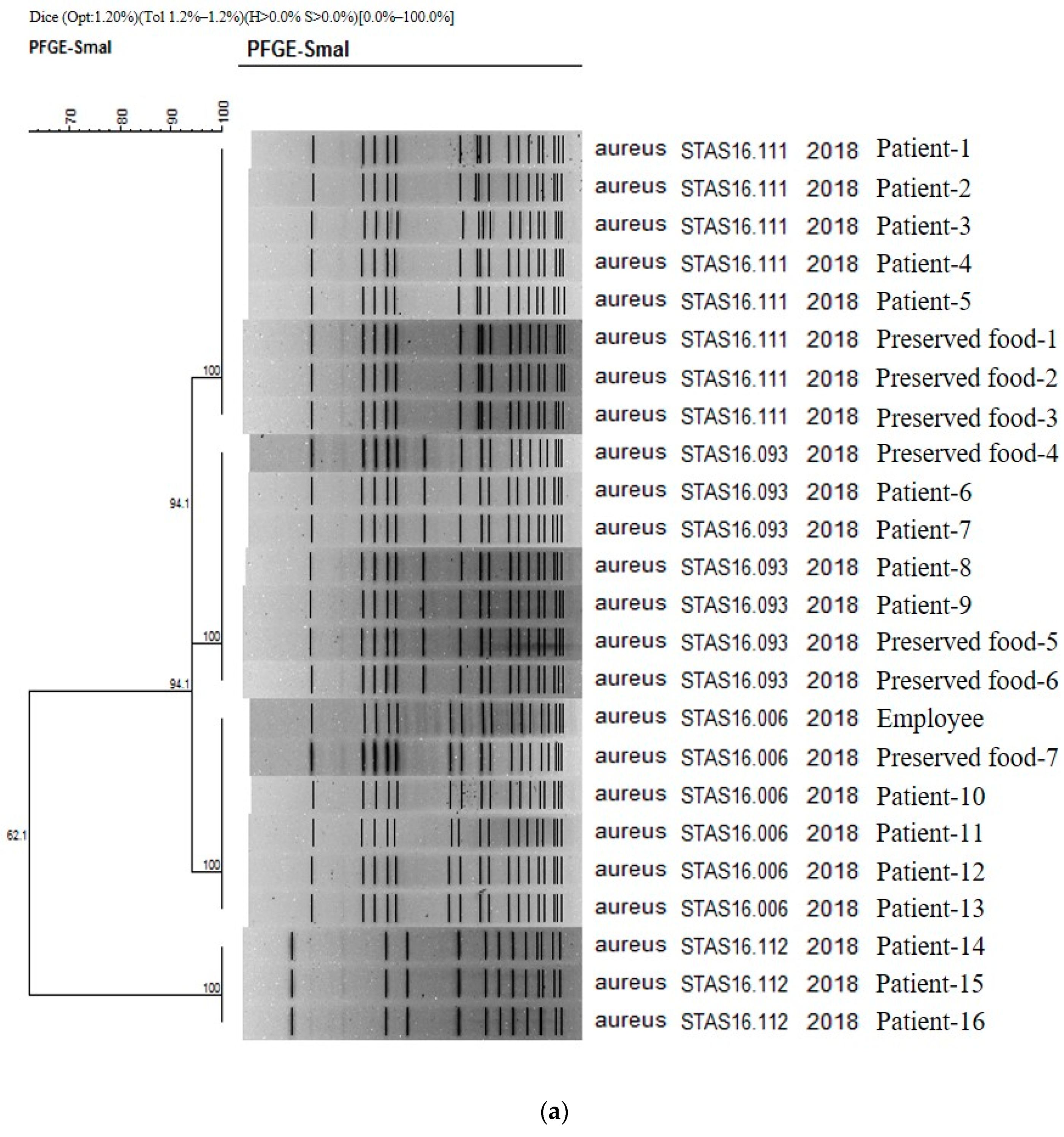
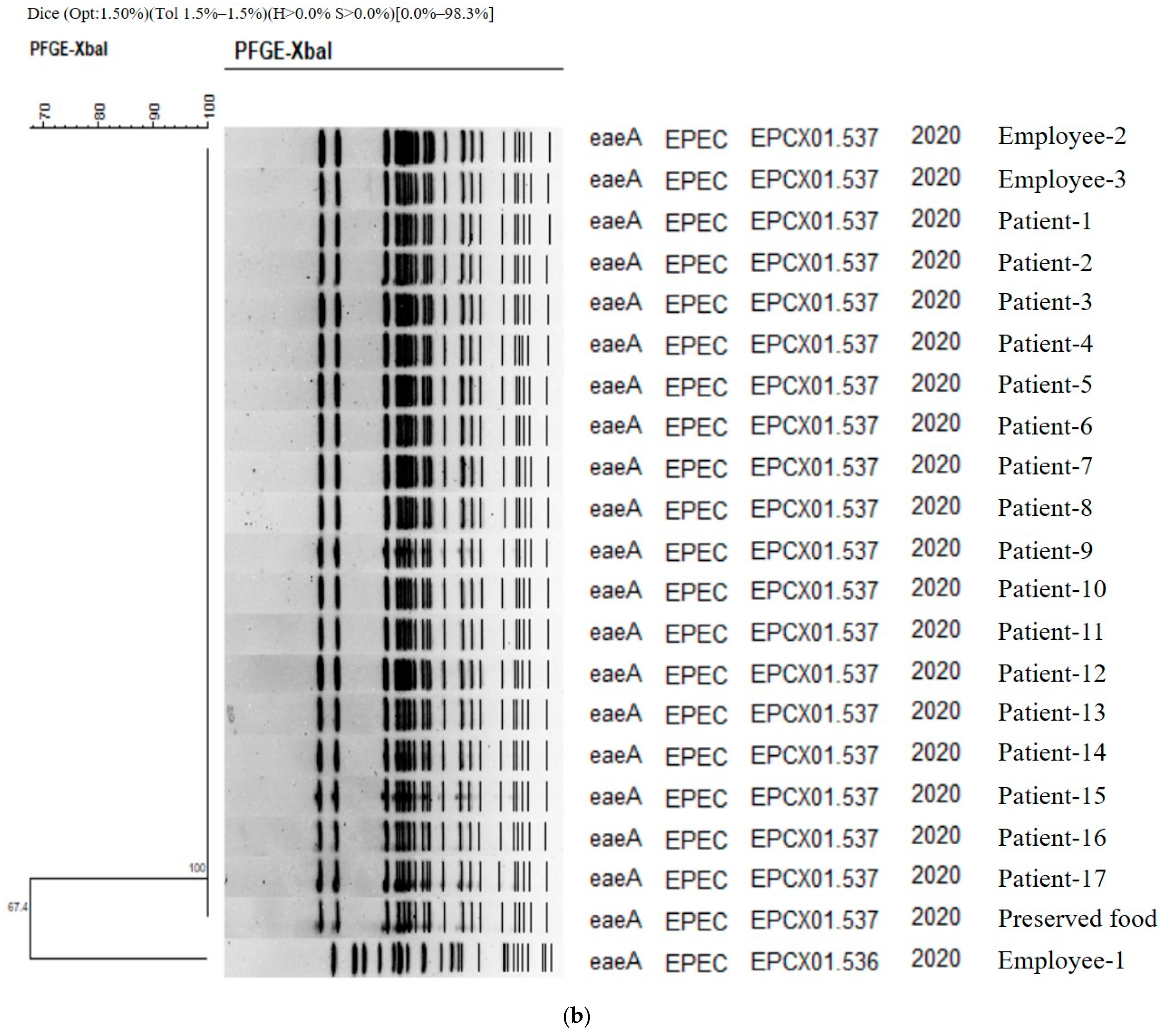
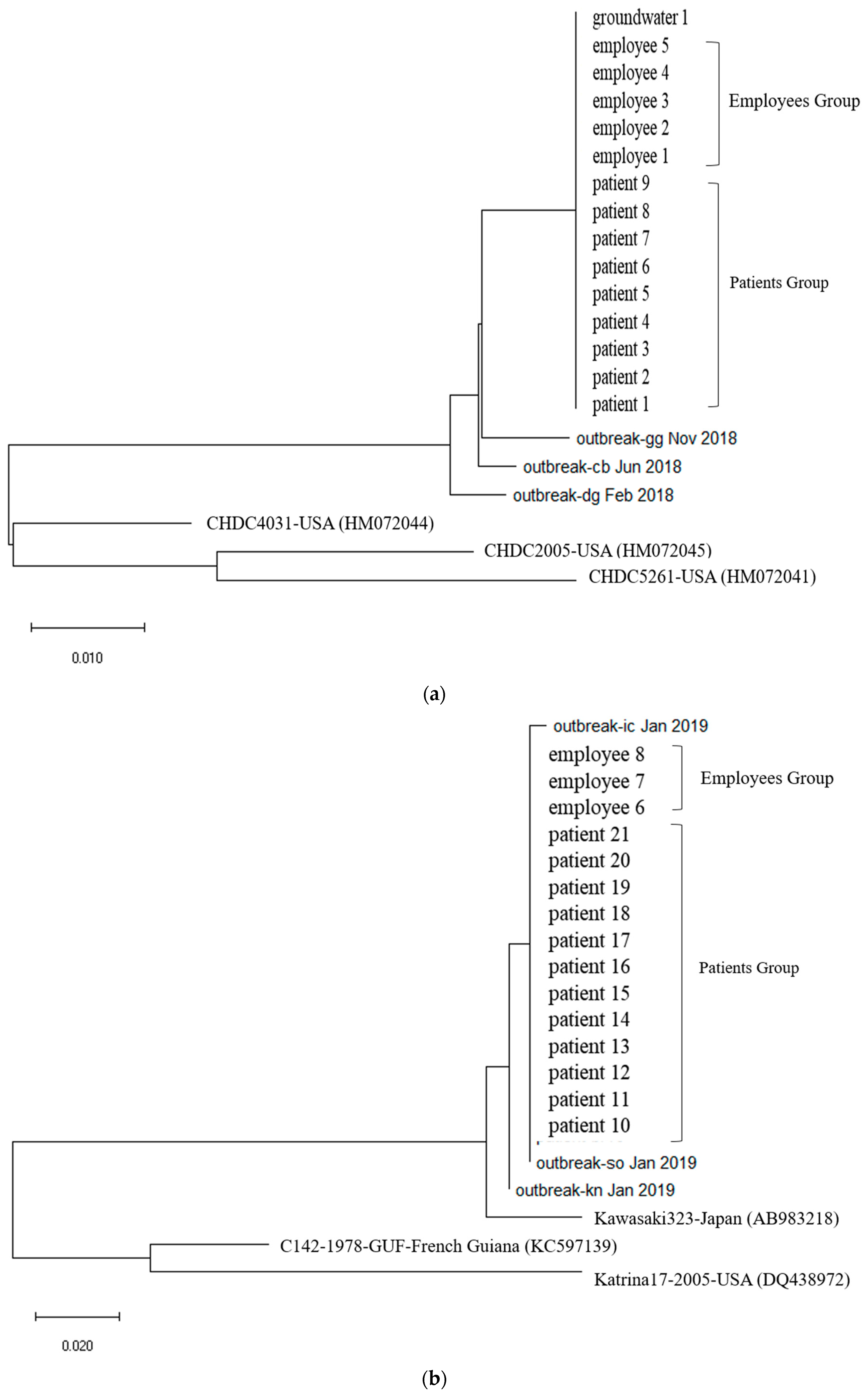
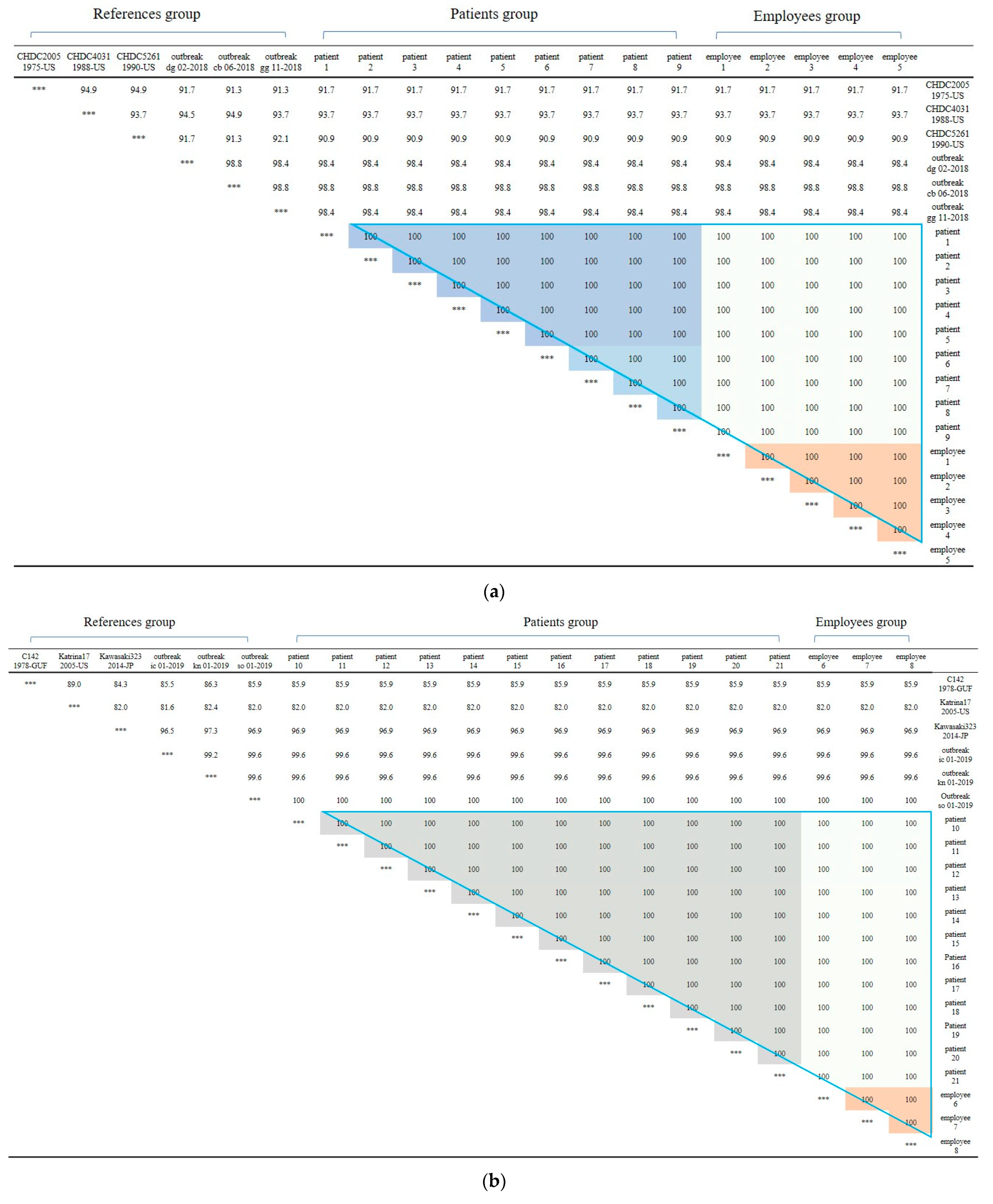
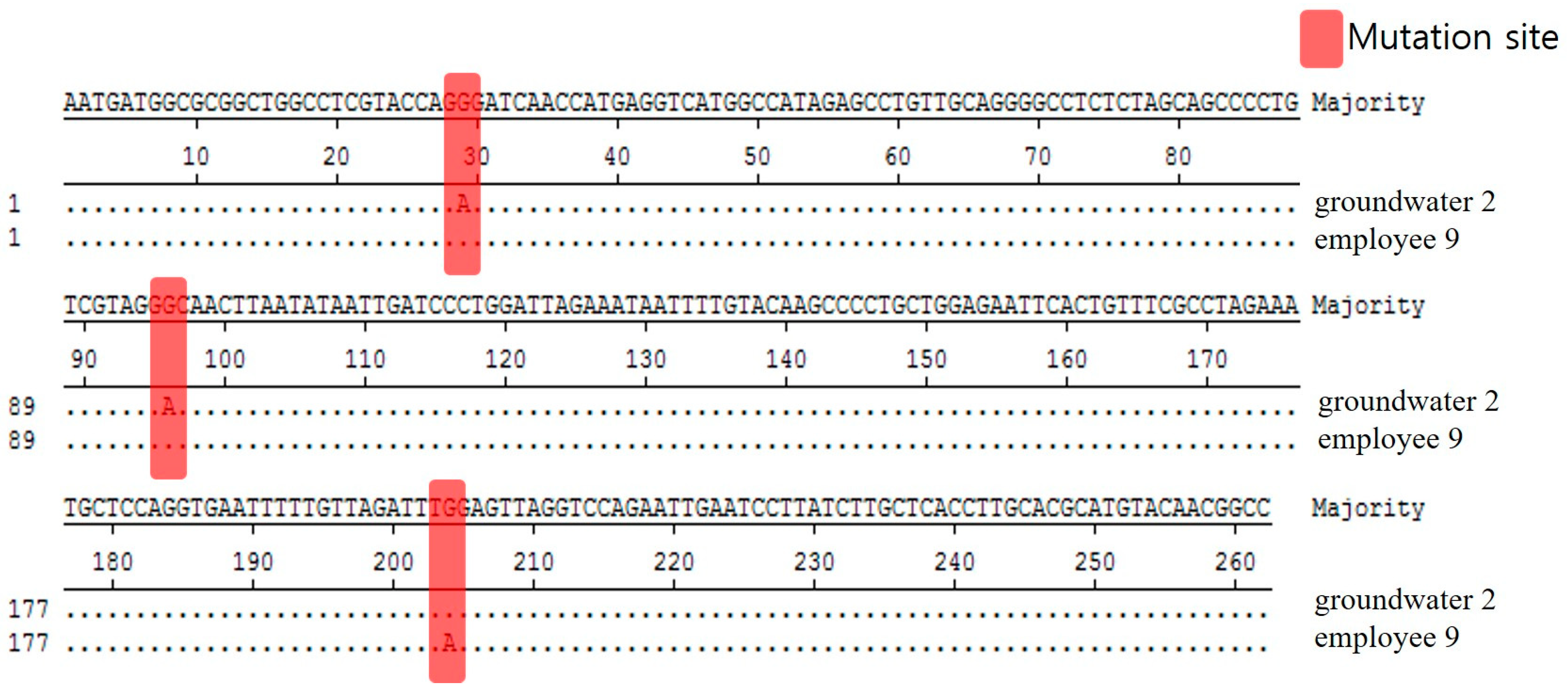

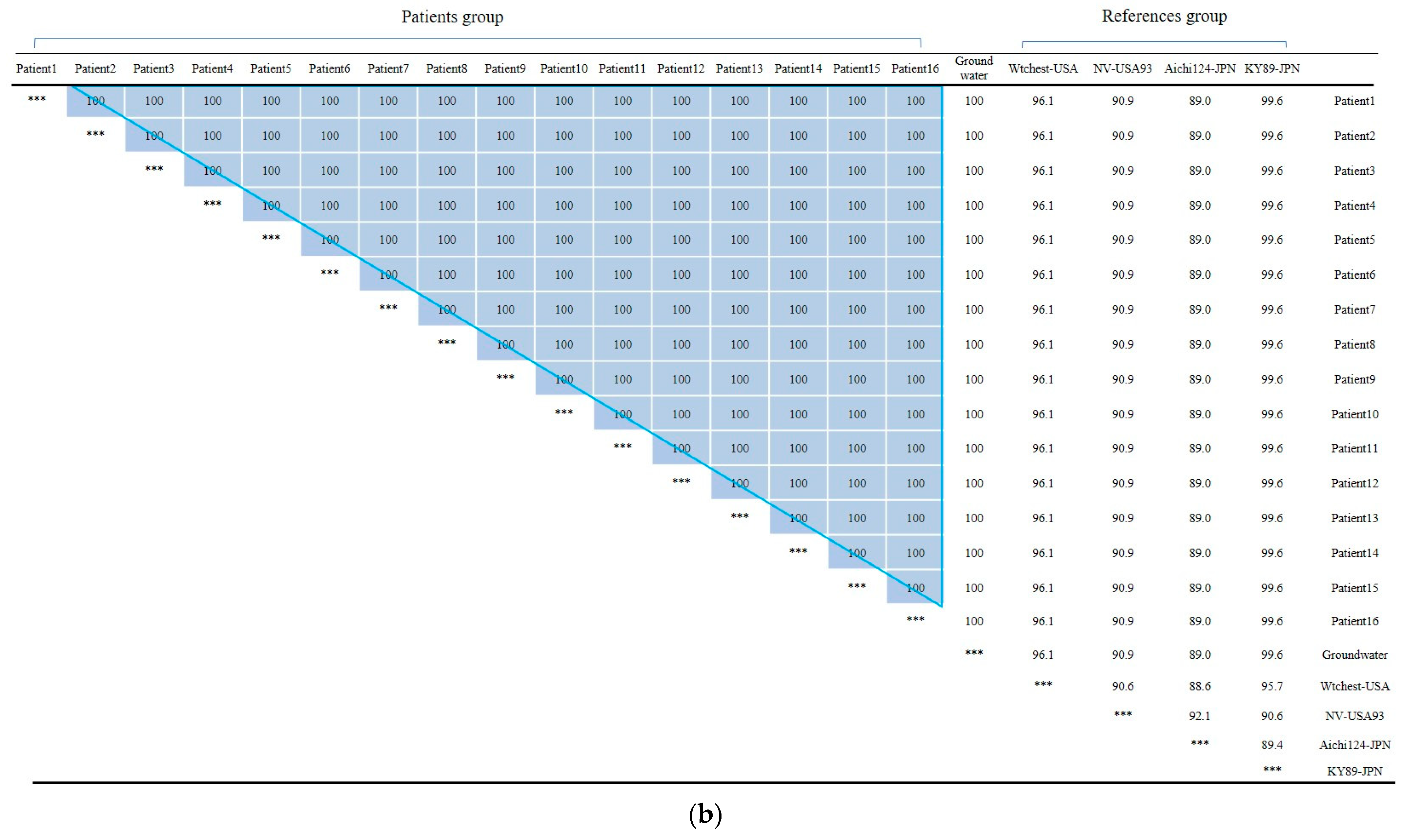
| Outbreak | Outbreak 1 | Outbreak 2 | Outbreak 3 | Outbreak 4 |
|---|---|---|---|---|
| Date of occurrence | 30 November 2018 | 9 January 2019 | 11 April 2019 | 25 June 2020 |
| Place of occurrence | Boryeong | Chenongyang | Geumsan | Asan |
| Facility of outbreak | Welfare center | Winter festival | High school | Cafeteria in company |
| Attack rate (%) | 26/200 (13%) | 38/101 (37.6%) | 53/194 (27.3%) | 94/402 (23.4%) |
| Incubation Period (mean hour) | 1–6.2 (4.7) | 33–41 | 23.5–40.5 (31.2) | |
| Suspected food & water | Rice cake, Fish pancake | Underground water | Underground water | Curry rice |
| Pathogen | S. aureus | Norovirus | Norovirus EAEC S. aureus | EPEC C. perfringens |
| Method | PFGE | Nucleotide sequencing | Nucleotide sequencing | PFGE |
| No. of positive/tested (%) | ||||
| Patient | 16/30 (53.3%) | 22/29 (75.9%) | 17/39 (43.6%) 21/39 (53.8%) 7/39 (17.9%) | 12/82 (14.6%) 13/82 (15.8%) |
| Cooking employee | 1/30 (3.3%) | 12/32 (37.5%) | 0/6 (0%) 1/6 (16.7%) 0/6 (0%) | 3/16 (18.8%) 0/16 (0%) |
| Preserved food | 7/10 (70.0%) | 0/0 (0%) | 0/72 (0%) 0/72 (0%) 0/72 (0%) | 1/135(0.7%) 0/135 (0%) |
| Environment Sample * | 0/9 (0) | 2/7 (28.6) | 5/19 (26.3) 1/95 (1.1%) 0/95 (0%) | 0/12 (0%) 0/12 (0%) |
| Cooking employees’ possibility of being the source of infection | Possible | Unlikely ** | Unlikely ** Unknown Unknown | Possible Unlikely |
| Pathogens | |
|---|---|
| Bacteria | Salmonella spp., Staphylococcus aureus, Vibrio parahaemolyticus, Vibrio cholerae, Vibrio vulnificus, Listeria monocytogenes, Shigella spp., Bacillus cereus, Yersinia enterocolitica, Campylobacter jejuni, Campylobacter coli, Clostridium perfringens, Clostridium botulinum, Pathogenic Escherichia coli (Enteropathgenic E. coli (EPEC), Enterohaemorrhagic E. coli (EHEC), Enterotoxigenic E. coli (ETEC), Enteroaggregative E. coli (EAEC), Enteroinvasive E coli (EIEC)) |
| Viruses | Norovirus, Hepatitis A virus, Rotavirus, Astrovirus, Sapovirus, Enteric Adenovirus, Hepatitis E virus |
Disclaimer/Publisher’s Note: The statements, opinions and data contained in all publications are solely those of the individual author(s) and contributor(s) and not of MDPI and/or the editor(s). MDPI and/or the editor(s) disclaim responsibility for any injury to people or property resulting from any ideas, methods, instructions or products referred to in the content. |
© 2024 by the authors. Licensee MDPI, Basel, Switzerland. This article is an open access article distributed under the terms and conditions of the Creative Commons Attribution (CC BY) license (https://creativecommons.org/licenses/by/4.0/).
Share and Cite
Park, M.-N.; Yeo, S.-G.; Park, J.; Jung, Y.; Hwang, S.-M. Usefulness and Limitations of PFGE Diagnosis and Nucleotide Sequencing Method in the Analysis of Food Poisoning Pathogens Found in Cooking Employees. Int. J. Mol. Sci. 2024, 25, 4123. https://doi.org/10.3390/ijms25074123
Park M-N, Yeo S-G, Park J, Jung Y, Hwang S-M. Usefulness and Limitations of PFGE Diagnosis and Nucleotide Sequencing Method in the Analysis of Food Poisoning Pathogens Found in Cooking Employees. International Journal of Molecular Sciences. 2024; 25(7):4123. https://doi.org/10.3390/ijms25074123
Chicago/Turabian StylePark, Mi-Na, Sang-Gu Yeo, Junhyuk Park, Yoomi Jung, and Se-Min Hwang. 2024. "Usefulness and Limitations of PFGE Diagnosis and Nucleotide Sequencing Method in the Analysis of Food Poisoning Pathogens Found in Cooking Employees" International Journal of Molecular Sciences 25, no. 7: 4123. https://doi.org/10.3390/ijms25074123
APA StylePark, M.-N., Yeo, S.-G., Park, J., Jung, Y., & Hwang, S.-M. (2024). Usefulness and Limitations of PFGE Diagnosis and Nucleotide Sequencing Method in the Analysis of Food Poisoning Pathogens Found in Cooking Employees. International Journal of Molecular Sciences, 25(7), 4123. https://doi.org/10.3390/ijms25074123






